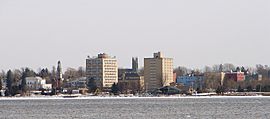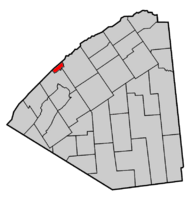Ogdensburg, New York facts for kids
Quick facts for kids
Ogdensburg
Kaniatarahòn:tsi
|
|
|---|---|
|
City
|
|
 |
|

Map highlighting Ogdensburg's location within St. Lawrence County.
|
|
| Country | United States |
| State | New York |
| County | St. Lawrence |
| Government | |
| • Type | Council-Manager |
| Area | |
| • Total | 8.14 sq mi (21.07 km2) |
| • Land | 4.96 sq mi (12.83 km2) |
| • Water | 3.18 sq mi (8.24 km2) |
| Elevation | 295 ft (90 m) |
| Population | |
| • Total | 10,064 |
| • Density | 2,029.03/sq mi (784.11/km2) |
| Time zone | UTC-5 (Eastern (EST)) |
| • Summer (DST) | UTC-4 (EDT) |
| Zip Code |
13669
|
| Area code(s) | 315 |
| FIPS code | 36-54485 |
| GNIS feature ID | 0976759 |
Ogdensburg is a city in St. Lawrence County, New York, United States. About 10,064 people lived here in 2020. This city was named after Samuel Ogden, a land owner, in the late 1700s.
Ogdensburg is located on the northern border of New York. It sits where the Oswegatchie River meets the St. Lawrence River. It is the only official city in St. Lawrence County. To its east is Massena, New York, and to its west is Brockville, Ontario in Canada.
Ogdensburg has the only U.S. port on the St. Lawrence Seaway. This waterway connects the Great Lakes to the Atlantic Ocean. The Ogdensburg–Prescott International Bridge links the United States and Canada. This bridge is northeast of the city and leads directly to Ottawa, the capital of Canada.
Contents
History of Ogdensburg
Early Inhabitants and French Settlement
People have lived in this area for at least 2,000 years. Around 1000 CE, Iroquoian-speaking people settled along the St. Lawrence River. They farmed, hunted, and fished. Early French explorers found villages of these people in the 1500s. Later, these villages were empty.
A group called the St. Lawrence Iroquoians lived here until the late 1500s. They likely disappeared due to wars with the Mohawk people. These wars were fought over the fur trade. By the time the French returned, the Iroquois Confederacy was strong. This group included the Mohawk, Onondaga, Oneida, Cayuga, and Seneca nations.
The first European settlement was a French mission. It was called Fort de La Présentation. Abbé Picquet built it in 1749. This fort was part of the French colony of New France. It attracted Native Americans for the fur trade. Many of them settled there and became Catholic. These Iroquois, mostly Onondaga, were known as Oswegatchie. By 1755, about 3,000 Iroquois lived at the mission.
British Control and American Settlement
The city is near where the Battle of the Thousand Islands happened in 1760. This battle was part of the Seven Years' War (also called the French and Indian War). After the British won, France gave its land in Canada to England. The English renamed the fort Fort Oswegatchie. The British allowed the Oswegatchie people and their Catholic priests to stay.
The village remained under British rule until 1796. This was after the American Revolutionary War. The new border was set by Jay's Treaty. The settlement then became part of the United States.
American settlers arrived in 1796. They caused many Oswegatchie people to leave the area. Many went to other Mohawk lands in Canada. The new American residents named the village Ogdensburgh. It was named after Samuel Ogden, an early landowner. The community grew around this settlement. It was the county seat from 1802 to 1828.
During the War of 1812, British forces captured the city. They wanted to end a blockade on the St. Lawrence River. Local merchants continued to trade with Canadian towns.
Ogdensburg became a village in 1817. It was officially made a city in 1868.
Modern History
In 1940, an important agreement was signed here. It was the Ogdensburg Agreement. Canadian Prime Minister Mackenzie King and United States President Franklin D. Roosevelt signed it. This agreement strengthened ties between the two countries. This happened after World War II started in Europe.
Sports
Ogdensburg has hosted many minor league baseball teams. This happened between 1900 and 1951. Teams like the Ogdensburg Colts and Ogdensburg Maples played here. They were part of leagues like the Canadian–American League. Some teams were linked to major league teams, like the Philadelphia Phillies. Games were played at Winter Park, now called Father Martin Park.
Climate
Ogdensburg has a humid continental climate. This means it has warm summers and cold, snowy winters.
| Climate data for Ogdensburg, New York (1991–2020 normals, extremes 1893–present) | |||||||||||||
|---|---|---|---|---|---|---|---|---|---|---|---|---|---|
| Month | Jan | Feb | Mar | Apr | May | Jun | Jul | Aug | Sep | Oct | Nov | Dec | Year |
| Record high °F (°C) | 66 (19) |
61 (16) |
81 (27) |
86 (30) |
95 (35) |
98 (37) |
100 (38) |
99 (37) |
96 (36) |
86 (30) |
76 (24) |
68 (20) |
100 (38) |
| Mean daily maximum °F (°C) | 25.9 (−3.4) |
28.5 (−1.9) |
38.1 (3.4) |
52.2 (11.2) |
66.3 (19.1) |
75.5 (24.2) |
79.7 (26.5) |
78.8 (26.0) |
71.2 (21.8) |
57.1 (13.9) |
44.5 (6.9) |
32.2 (0.1) |
54.2 (12.3) |
| Daily mean °F (°C) | 16.9 (−8.4) |
18.9 (−7.3) |
28.8 (−1.8) |
43.0 (6.1) |
56.4 (13.6) |
65.6 (18.7) |
70.5 (21.4) |
68.9 (20.5) |
60.8 (16.0) |
48.5 (9.2) |
36.6 (2.6) |
24.9 (−3.9) |
45.0 (7.2) |
| Mean daily minimum °F (°C) | 7.8 (−13.4) |
9.4 (−12.6) |
19.5 (−6.9) |
33.8 (1.0) |
46.5 (8.1) |
55.7 (13.2) |
61.2 (16.2) |
58.9 (14.9) |
50.4 (10.2) |
39.9 (4.4) |
28.7 (−1.8) |
17.6 (−8.0) |
35.8 (2.1) |
| Record low °F (°C) | −43 (−42) |
−37 (−38) |
−24 (−31) |
0 (−18) |
20 (−7) |
31 (−1) |
40 (4) |
35 (2) |
21 (−6) |
14 (−10) |
−7 (−22) |
−42 (−41) |
−43 (−42) |
| Average precipitation inches (mm) | 2.76 (70) |
1.79 (45) |
2.58 (66) |
3.04 (77) |
3.11 (79) |
4.13 (105) |
3.86 (98) |
3.65 (93) |
4.03 (102) |
3.90 (99) |
3.10 (79) |
3.26 (83) |
39.21 (996) |
| Source: NOAA | |||||||||||||
Historic Places in Ogdensburg
Many buildings and sites in Ogdensburg are listed on the National Register of Historic Places. These include:
- Library Park Historic District
- Judge John Fine House
- Acker and Evans Law Office
- New York State Armory
- Ogdensburg Harbor Light
- Oswegatchie Pumping Station
- Ogdensburg Armory
- Robert C. McEwen United States Custom House
- United States Post Office
- Fort de La Présentation Site
Population Changes
| Historical population | |||
|---|---|---|---|
| Census | Pop. | %± | |
| 1860 | 7,409 | — | |
| 1870 | 10,076 | 36.0% | |
| 1880 | 10,341 | 2.6% | |
| 1890 | 11,662 | 12.8% | |
| 1900 | 12,633 | 8.3% | |
| 1910 | 15,933 | 26.1% | |
| 1920 | 14,609 | −8.3% | |
| 1930 | 16,915 | 15.8% | |
| 1940 | 16,346 | −3.4% | |
| 1950 | 16,166 | −1.1% | |
| 1960 | 16,122 | −0.3% | |
| 1970 | 14,554 | −9.7% | |
| 1980 | 12,375 | −15.0% | |
| 1990 | 13,521 | 9.3% | |
| 2000 | 12,364 | −8.6% | |
| 2010 | 11,128 | −10.0% | |
| 2020 | 10,064 | −9.6% | |
| U.S. Decennial Census | |||
In 2000, Ogdensburg had 12,364 people. The population has changed over the years. In 2020, it was 10,064 people.
Education
Most of Ogdensburg is part of the Ogdensburg City School District. A small part is in the Lisbon Central School District.
Schools in Ogdensburg include:
- Ogdensburg Free Academy
- John F. Kennedy Elementary
- Grant C. Madill Elementary
Community Resources
Ogdensburg offers several important resources for its residents.
Health and Library Services
The St. Lawrence Psychiatric Center helps people with mental health needs. It offers services for both those staying there and those who visit. The Ogdensburg Public Library provides many services. These include free internet, computers, DVD and Blu-ray rentals, books, and audiobooks. They have programs for teens, children, and adults.
Museums and Historical Sites
The Frederic Remington Art Museum is in downtown Ogdensburg. It is in the old home of David Parish, a local businessman. Frederic Remington was a famous artist known for his paintings of the American West. The museum has many of his artworks and items.
The Fort La Presentation Association is working to rebuild the mission fort. They want to make it a living history museum. This will help people learn about the area's diverse history.
Other Facilities
Ogdensburg has two correctional facilities: Riverview and Ogdensburg. These facilities provide jobs for people in the area.
Ogdensburg is also a place where Canadians can pick up packages. Many Canadians order things online from U.S. companies. They have them sent to package receiving companies in Ogdensburg. Then, they drive to Ogdensburg to get their items. This is often because U.S. companies do not ship to Canada or charge more for it.
A private school called Mater Dei College used to be in Ogdensburg but is now closed. Later, from 2001 to 2009, the Academy at Ivy Ridge used the campus. This school was for kids aged 11–18 who had behavioral issues. In 2024, a documentary series called The Program: Cons, Cults, and Kidnapping explored the academy.
Transportation
Ogdensburg became an important trading city in the mid-1800s. This was when railroads were built in northern New York and Canada. Railroads like the Ogdensburg and Lake Champlain Railroad connected towns. Passenger train service ended in 1961.
The Ogdensburg-Prescott International Bridge was built in 1960. It connects Ogdensburg to Johnstown, Ontario, Canada. This bridge leads to a direct road to Ottawa.
The Ogdensburg International Airport is located south of the city.
Events
Ogdensburg hosts fun events throughout the year:
- The Ogdensburg Boys & Girls Club Expo is held in March. It helps raise money for the club.
- The Ogdensburg International Seaway Festival happens in the last full week of July. It includes the Remington Canoe Race, a high school band competition, craft shows, and a classic car show. The festival ends with fireworks and a parade.
Notable People
Many well-known people are from Ogdensburg or have lived there:
- Rick Carlisle, NBA head coach and former basketball player
- Lawrence S Churchill, U.S. Army Air Corp colonel
- Sally James Farnham, sculptor
- John Fine, United States Representative
- Charlie Gogolak, NFL placekicker
- Pete Gogolak, AFL and NFL placekicker, first soccer-style kicker in pro football
- Jimmy Howard, professional hockey goaltender for the Detroit Red Wings
- Margaret Jacobs, artist
- Preston King, Collector of the Port of New York
- James A. Lindsay, mathematician and author
- George R. Malby, former U.S. Congressman
- Robert C. McEwen, United States Representative
- John Mosher, writer and film critic
- Audrey Munson, artist's model and film actress
- Robert Odlum, first person to jump off the Brooklyn Bridge
- Henry R. Paige, major general in the Marine Corps
- Frederic Remington, famous American artist
- Brenda Romero, game designer and writer
- Mark Valley, actor and comedian
- Joseph Vilas, Wisconsin state senator and businessman
- M. Emmet Walsh, actor
Radio Stations
- WPAC-FM PAC 98.7
- WVLF-FM Mix 96.1
- WRCD-FM 101.5 The Fox
See also
 In Spanish: Ogdensburg (Nueva York) para niños
In Spanish: Ogdensburg (Nueva York) para niños


